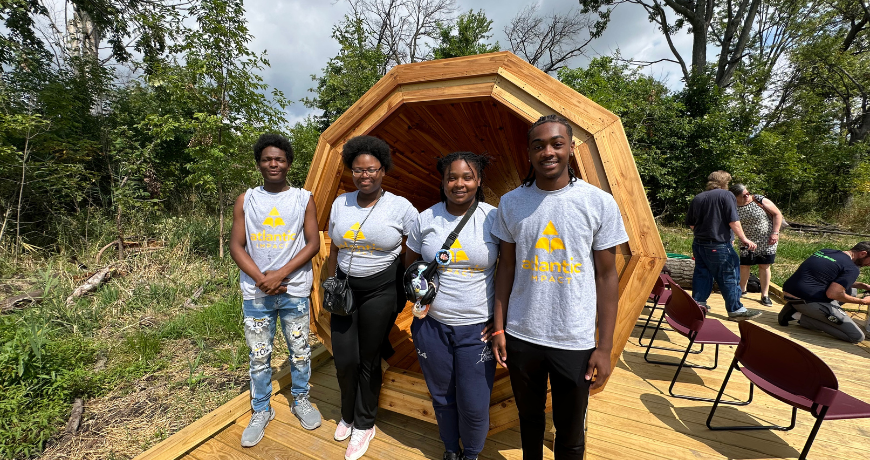On Belle Isle, where families have always come to fish off the bridge, walk the trails, or gather for Sunday cookouts, a new kind of landmark was unveiled this week. At first glance, it looks like an oversized wooden cone tucked off the path near the Belle Isle Nature Center. But it’s not just decoration. When you step inside the ten-foot structure, the park itself starts talking back. The birds overhead, the wind through the leaves, even the faint stirring of water in the marsh — all of it swells louder, amplified by what’s being called Detroit’s first “nature megaphone.”
What makes it stand out isn’t just the shape. It’s who built it. Detroit high school students, some who had never touched a saw before, took on the challenge of designing and constructing something that most adults would call ambitious. The advanced carpentry required sharp angles and clean alignment, the kind of measurements that don’t forgive mistakes. Yet, piece by piece, they put it together through Atlantic Impact, a Detroit nonprofit that runs skilled trades training for young people.
When the ribbon was cut — with the students themselves lining up to hold the scissors — the pride was visible. A few grinned wide, others tried to play it cool, but they all knew they had done something that would outlast them. In a city where too often young people are written off as problems to be solved, here was the opposite: a permanent structure on Detroit’s most iconic public island, built entirely by their hands.
The megaphone sits on a raised platform in one of Belle Isle’s rarer ecosystems, a wet-mesic flatwoods forest. It’s the kind of place that floods in spring, dries in the summer, and always carries the pulse of life if you slow down long enough to notice it. That’s what the megaphone demands — stillness. You don’t shout into it. You step inside, sit down, and let the forest sound off. Some visitors at the opening needed that explained. They leaned toward the narrower end, ready to yell into it like a cone at a pep rally. The students had to smile and show them: this isn’t for your voice, it’s for the park’s.
The Michigan Department of Natural Resources, which manages Belle Isle State Park, backed the project and helped make sure it would hold up to the weather and heavy foot traffic. For them, it’s a way to connect Detroiters to an island that’s always been more than green space. Generations of Black families made Belle Isle their escape when segregation locked them out of other parks. It’s where the city has gathered in times of joy and in times of tension. Older Detroiters still remember the 1943 race riot that began near the Belle Isle Bridge and spread through the city, changing how Detroit and the nation talked about race. Others remember family reunions, fireworks, and Sunday afternoons when the park felt like one big block party. Now, tucked into those same woods, is a structure that ties today’s young people into that story of belonging.
What Atlantic Impact built here is a spotlight on workforce and art simultaneously. The nonprofit has long argued that Detroit’s students need more than classrooms to prepare for the future — they need real projects, real responsibility, and the chance to see their work matter. Building the megaphone wasn’t just a test of carpentry. It required teamwork, patience, problem-solving when the math didn’t add up, and the confidence to adjust when cuts didn’t fit the first time. Those are the skills tradespeople and designers alike carry into careers.
The megaphone also flips the usual script. Too often, programs for Detroit youth showcase what they lack. Here’s the opposite: evidence of what happens when they’re given tools, space, and trust. The end result is something that looks like public art, functions as an acoustic installation, and lives as proof of possibility.
By the end of the ceremony, families had started climbing in. Kids leaned back against the wood, eyes wide as the chirps and rustles around them echoed louder. Parents took photos. The students who built it lingered nearby, some pointing out the corners they had measured, others quietly watching as strangers enjoyed what they had created. For them, this wasn’t just another school project that gets graded and forgotten. It was a permanent piece of Detroit.
Belle Isle has always been layered — natural beauty, city grit, and deep cultural history. Adding a nature megaphone only deepens that mix. It gives people one more reason to slow down, one more way to see — or in this case hear — the island differently. Early mornings and evenings are expected to be the best times, when the birds are most active and the marsh comes alive. But whenever someone steps inside, the echoes of those student builders will be there too.
And there’s something about its placement that feels symbolic. Belle Isle is where generations of Detroiters have come to claim space, to carve out joy against the backdrop of hardship. From the Motown years when families gathered here after parades, to the long tradition of Black Detroiters using the park as a meeting ground for clubs, churches, and neighborhoods, Belle Isle has always been more than a park. It’s memory, legacy, and resistance all in one. Now, Detroit youth have literally built their own contribution into that landscape.
It’s rare that a project can pull together environment, innovation, and youth empowerment all at once. On Belle Isle, Detroit just gained one. And in a time when so many headlines about young people lean toward the negative, this structure amplifies a different message altogether — the sound of a city’s next generation learning to build, to lead, and to leave something lasting behind.

